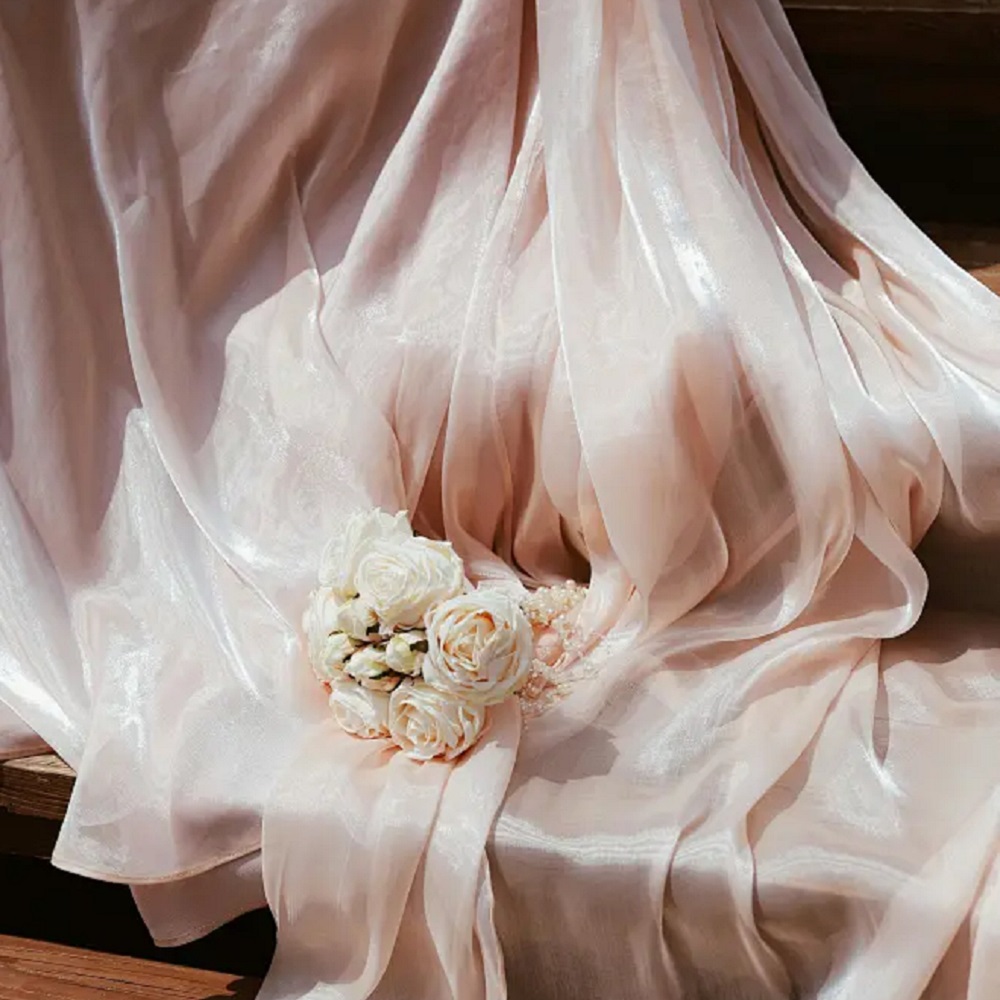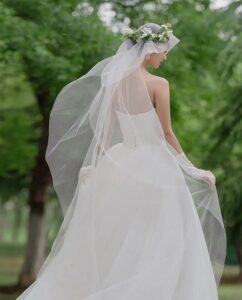What is Chiffon Fabric: Properties, How It’s Made and Online Buying Guide

Chiffon, known for its ethereal and delicate charm, has been a favorite in fashion and home decor for decades. Its lightweight, flowing texture makes it a popular choice among designers and sewing enthusiasts. But for many people who just want a fabric suitable for flowing dresses, blouses and others, they may not be familiar with the various types and compositions of chiffon, and don’t know how to choose. In this guide, we’ll let you know about what chiffon fabric is, its characteristics, how it is made, common uses, and tips for caring for and buy chiffon fabric online. Let’s get to it!
What is Chiffon Fabric?
Chiffon is a sheer, lightweight fabric characterized by its softness and flowiness. The word “chiffon” comes from the French word for “cloth” or “rag.” It is a plain weave with fine threads crisscrossed to create a slightly translucent texture. Chiffon was originally made from silk, but today it can be easily made from other synthetic fibers such as polyester or nylon. Synthetic fibers can mimic the natural sheen of silk quite well, though not perfectly. The main reason for their popularity is that they are much cheaper than natural silk.
What are the Properties of Chiffon?
Sheer: Mostly, chiffon has a sheer, transparent appearance. When held up to the light, the outline of the skin can be vaguely revealed. Looking closely, it looks like a fine net or mesh.
Textured: Chiffon has a slightly bumpy surface due to the twisted threads used in weaving. Running your fingers over it, you can feel the subtle ridges that give the fabric depth.
Flexible: Chiffon stretches just a little. Silk versions feel softer and more pliable, while polyester versions are slightly stiffer.
Durable: Despite its delicate appearance, chiffon is surprisingly strong. The tight weave and twisted yarns help it resist tearing.
Shiny: Chiffon has a gentle shimmer. Silk chiffon catches light more vividly, whereas synthetic versions have a softer, understated glow.
How Chiffon Fabric is Made
The production of chiffon fabric involves complex processes that vary depending on the material used. Here’s how different types of chiffon fabric are made:
Silk Chiffon: Made from silkworm cocoons, where the silk fibers are spun into fine threads. These threads are tightly twisted and woven in a plain weave, creating a lightweight fabric with slightly puckered texture. The process is labor-intensive, which makes silk chiffon relatively expensive.
Polyester Chiffon: Crafted from synthetic polyester fibers, this chiffon is both durable and wrinkle-resistant. This fabric is woven similarly to silk but are more durable and cost-effective.
Nylon Chiffon: Woven from nylon fibers, this chiffon is lightweight yet strong. The tightly twisted weave gives it a subtle texture and enough flexibility for repeated use.
Rayon Chiffon: Produced from natural cellulose fibers, rayon chiffon feels soft and breathable. Its fine weave gives a light, flowing drape with a gentle sheen, offering a silk-like look at a lower cost.
Regardless of the material, the weaving process uses highly twisted yarns to create chiffon’s signature light and airy texture.
Pros and Cons of Using Chiffon
Pros:
Aesthetic Appeal: Its airy, translucent quality adds elegance to any design.
Versatility: Suitable for clothing (dresses, blouses, bridal wear) and home decor (curtains, table runners). For home decor, we recommend polyester chiffon.
Breathability: Chiffon is lightweight and silky to the touch, ideal for warm climates or layered looks.
Dyeability: Easy to dye, offering vibrant color options. ( Except polyester)
Cons:
Delicate Nature: Silk chiffon is prone to snagging and tearing, requiring careful handling.
Maintenance: It often needs hand-washing or dry cleaning, especially for silk variants.
Cost: Silk chiffon can be expensive compared to synthetic alternatives.
What Is Chiffon Used For?
Evening Gowns: With its lightweight and flowing texture, chiffon makes evening dresses look elegant and charming. As you walk, the layers of the dresses shift gracefully, giving each gown an elegant flow.
Blouses: Lightweight and breathable, chiffon is popular for making summertime stylish blouses and tops. Its airy drape lets you create elegant folds and ruffles without adding any bulk.
Bridal Wear: Perfect for veils, overlays, and layered skirts in wedding dresses. Chiffon adds a soft and romantic touch to bridal gowns.
Lingerie: Chiffon is gentle and smooth, providing a luxurious feel next to the skin. Its sheer quality adds an elegant, delicate touch to intimate garments.
Scarves: Lightweight and easy to drape, chiffon scarves flow naturally around the shoulders or neck. The soft texture not only brings a comfortable wearing experience, but also adds a sense of fashion.
Sarees and Dupattas: These are common pieces in South Asian traditional clothing, which need fabrics that are light and drape well. Chiffon is a popular choice for making sarees and dupattas. It’s lightweight, flows beautifully, and drapes perfectly, making layers and folds look elegant without feeling heavy.
Home Décor: Used for sheer curtains, table overlays, and decorative accents. Chiffon adds a light, airy feel to interiors, softening sunlight and creating a gentle atmosphere.

How to Care for Chiffon Fabric
Washing: For silk chiffon, always hand wash in cold water with a gentle detergent, and swirl softly. For nylon, polyester, and rayon chiffon, you can hand wash or wash in a washing machine on cold water.
Drying: Air-dry chiffon away from direct sunlight to prevent fading. Avoid wringing to maintain its shape.
Ironing: Use a low-heat setting with a pressing cloth to avoid scorching. Steam ironing works well for removing wrinkles.
Storage: Store in a cool, dry place, folded loosely or hung to prevent creases. Avoid heavy stacking to prevent crushing.
Online Buying Guide for Chiffon
When looking to buy fabric online, consider these tips to ensure quality and value:
Choose a Reputable Supplier: Look for a trusted chiffon fabric supplier with positive reviews and transparent sourcing. Check if they offer detailed product descriptions, including fiber content (silk, polyester, or others).
Verify Quality: Request samples if possible, especially for high-end projects. Ensure the fabric’s weight matches your needs. Lightweight chiffon flows beautifully but may need lining, while heavier chiffon has more body and is easier to handle for layered designs.
Color and Pattern Accuracy: Colors can look different on screen. Read descriptions carefully and ask for real color cards if possible.
Check Sustainability: If you’re concerned about sustainability, choose suppliers that offer eco-friendly chiffon, such as recycled polyester or organic silk.
Shipping and Delivery: Confirm shipping times and costs, especially for international orders, to avoid delays.
Minimum Order Quantity: When purchasing chiffon fabric wholesale, check the supplier’s minimum order quantity requirements.
By following these steps, you can confidently purchase chiffon that meets your project’s aesthetic and functional requirements.
FAQs
1. Is chiffon see-through?
Yes, most chiffon fabrics are quite sheer. Lightweight layers can reveal a hint of skin underneath, so lining is often used for dresses and blouses.
2. Does chiffon wrinkle easily?
Silk chiffon can wrinkle, especially if folded tightly, while synthetic chiffons like polyester or nylon are more resistant. Hanging or loosely folding the fabric helps prevent creases.
3. Is chiffon difficult to sew?
Yes, it can be a bit tricky, especially silk chiffon. It’s lightweight, slippery, and frays easily, so cutting and stitching require patience and care. Using sharp scissors, fine needles, and minimal pins can make sewing much easier.
4. How do I prevent chiffon from slipping or rolling while sewing?
Many people place tissue paper under the fabric or use clips instead of pins to keep it steady. Working slowly and carefully helps, and pressing seams gently keeps the fabric smooth.
5: What should I choose between silk chiffon or polyester chiffon?
Silk chiffon is soft, luxurious, and drapes beautifully, perfect for elegant gowns or bridal wear, but it needs careful washing and costs quite a bit. Polyester chiffon is more durable, budget-friendly, and easier to care for, still flowing nicely for everyday tops or scarves.
If you have any questions or need help choosing the right chiffon for your project, feel free to reach out to Facto Textile, we’re happy to help!
Working With Facto Textile
We promise you:
- A wide variety of high- quality fabrics
- Full range of customized services
- Professional production technology
- Sincere Cooperation
Contact Us To Start Your Fabric Project
Please send us your message, we will reply within 20 hours.
